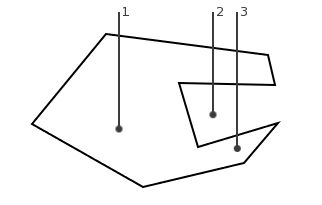Point-in-polygon: Jordan Curve Theorem
Calculating whenever a point is inside a polygon can sometimes be a hard and costly calculation. This article describes a quite cheap solution to calculate whenever a point is inside ANY closed polygon. In an open polygon it's hard to determine what's in and out so naturally it won't work.
The Jordan Curve Theorem states that a point is inside a polygon if the number of crossings from an arbitrary direction is odd. An image explains more than a thousand words so lets take a look at the picture. As you can see point 1 and 3 is inside the polygon but point 2 isn't. Follow the rays from each point and count each time you cross a line-segment. In this article I only deal with 2D polygons but it can easily used in a 3D-environment.
Contents
Find crossings[edit]
Casting a ray[edit]
One of the first things to do is to cast a ray from the point in an arbitrary direction. I use a ray along the Y axis (pointing upwards as in the picture) for simplicity. Along X-axis is good too, but use one of those or it gets a lot harder. Remember that I use the ray mentioned above throughout this article.
Finding the equation of a line-segment[edit]
As a first step, if the ray is along y-axis, check if the point x-coordinate is between the two points connecting the line. If not it don't cross it either. You can also check if the y-coordinate is above both points. The next step is to find the equation of the line. Hopefully you remember this from grade school. The equation of a straight line is $ y=kx+m\, $ (Swedish notation). The slope is $ k=\frac{\Delta\ y}{\Delta\ x} $ and offset is $ m=y-kx\, $. Do the math we have the equation. Now, insert the x-coordinate of the point into the equation. If the result is larger than the y-coordinate the ray does not cross the line-segment.
Repeat this for each line-segment.
C/C++ implementation[edit]
- /* The points creating the polygon. */
- float x[8];
- float y[8];
- float x1,x2;
- /* The coordinates of the point */
- float px, py;
- /* How many times the ray crosses a line-segment */
- int crossings = 0;
- /* Coordinates of the points */
- x[0] = 100; y[0] = 100;
- x[1] = 200; y[1] = 200;
- x[2] = 300; y[2] = 200;
- x[3] = 300; y[3] = 170;
- x[4] = 240; y[4] = 170;
- x[5] = 240; y[5] = 90;
- x[6] = 330; y[6] = 140;
- x[7] = 270; y[7] = 30;
- /* Iterate through each line */
- for ( int i = 0; i < 8; i++ ){
- /* This is done to ensure that we get the same result when
- the line goes from left to right and right to left */
- if ( x[i] < x[ (i+1)%8 ] ){
- x1 = x[i];
- x2 = x[(i+1)%8];
- } else {
- x1 = x[(i+1)%8];
- x2 = x[i];
- }
- /* First check if the ray is possible to cross the line */
- if ( px > x1 && px <= x2 && ( py < y[i] || py <= y[(i+1)%8] ) ) {
- static const float eps = 0.000001;
- /* Calculate the equation of the line */
- float dx = x[(i+1)%8] - x[i];
- float dy = y[(i+1)%8] - y[i];
- float k;
- if ( fabs(dx) < eps ){
- k = INFINITY; // math.h
- } else {
- k = dy/dx;
- }
- float m = y[i] - k * x[i];
- /* Find if the ray crosses the line */
- float y2 = k * px + m;
- if ( py <= y2 ){
- crossings++;
- }
- }
- }
- printf("The point is crossing %d lines", crossings);
- if ( crossings % 2 == 1 ){
- printf(" thus it is inside the polygon");
- }
- printf("\n");
